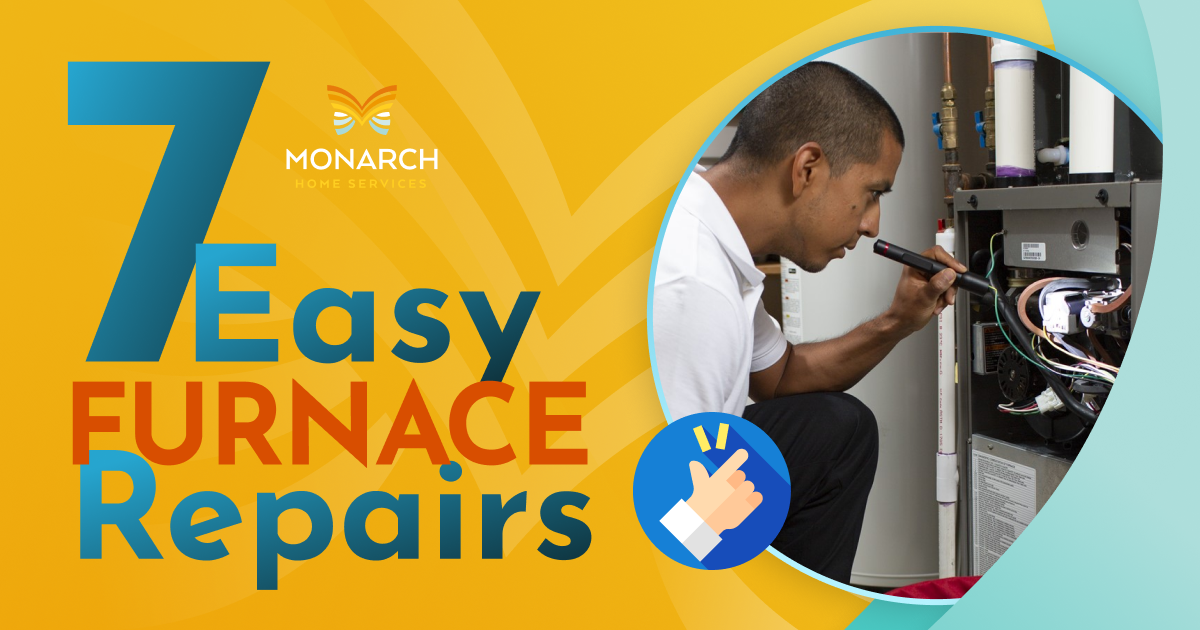
Generally, furnace repair is not for a DIYer. But not every furnace problem requires calling a heating company. There are a few steps you can try before paying for a service visit. While modern furnaces are complex systems consisting of heating elements, sensors, motors, pipes, safety components, and computers, some issues can be addressed quite easily.
We don’t recommend attempting a complicated heating repair without experience, but here are 7 ways to get your furnace running again.
1. Check the Power
Your furnace may not be working because it’s not receiving power. The first step is to check the switch on the side of the furnace. If it’s off, flip it to the “On” position and see if the unit kicks in. If not, find the circuit breaker for the furnace in the electrical panel. Reset the breaker if it has tripped (but call a furnace repair technician or electrician if the breaker trips again soon after).
2. Replace the Filter
A clogged filter can cause the furnace to shut down. This is because restricted airflow causes the unit to overheat, which is detected by the high-limit switch. The switch signals the computer to shut off the burners when the temperature inside the furnace becomes too high. The furnace will turn on again once it cools, but after a few times, the computer may shut the system down until it’s repaired.
Fortunately, replacing a filter is easy. If the filter is dirty or clogged, remove it and install a new, clean filter. Restart the furnace by turning off the power switch, waiting five minutes, and then restoring power and letting the furnace cycle on.
3. Replace the Limit Switch
If the furnace doesn’t start after replacing the filter, the high-limit switch may have been damaged by overheating. Check the owner’s manual or the wiring diagram on the furnace door to locate the switch. A bad switch can be removed by loosening the retaining screws and pulling it out of the heat exchanger. Install the new switch in the same position as the sensor (or call a professional to ensure it’s done properly).
4. Check the Thermostat
A heating issue doesn’t always involve the furnace. To troubleshoot the matter, check the thermostat. If the furnace isn’t blowing hot air or won’t turn on, try the following steps:
- Check the setting; if the thermostat is on “Cool”, set it to “Heat”.
- Set the temperature 5℉ higher than the room temperature.
- If the thermostat isn’t responding, change the batteries.
- Open the thermostat panel to clean out any dust or debris.
- Check that the program shows the right day and time.
- Examine the thermostat wires for breaks or damage (call for help if any are found).
5. Check the Gas Valve
A gas furnace won’t blow hot air if it isn’t receiving fuel. Look for the gas valve and see if it is turned on. If not, someone may have forgotten to do so. To find the valve, trace the gas line from the furnace to the meter and look for a handle. If this handle is perpendicular to the pipe, the gas supply is off; turn the handle until it’s parallel with the gas line.
6. Install a New Ignitor or Flame Sensor
A “hot surface” ignitor can crack and fail after so many heating/cooling cycles (after all, it heats up to 1,800℉). The igniter lights the burners, which then heat the flame sensor, which is also prone to wear and corrosion.
Replacing these components is a simple furnace repair. If you feel confident, check whether the ignitor is secured by screws or a clip. The old part can be taken out by removing the screws or unsnapping the retainer clip. Now remove the old ignitor (you can also remove the flame sensor and clean it; or, you can replace it and slide the new sensor into place).
Next, install a new ignitor by screwing it or snapping it into its fitting and plugging its electrical connector into the wiring harness. Avoid touching it with your skin or bumping it against hard surfaces.
7. Clear the Pressure Switch Tubing
If you have a condensing gas furnace, the pressure switch tubing can become filled with condensation from water extracted from exhaust gases. Clearing this silicone tubing, which runs from the heat exchanger to the flue, requires removing it and blowing it out with compressed air.
This project requires tools such as a 4-in-1 screwdriver, adjustable wrench, air compressor, air hose, voltage tester, and flashlight. Blowing out the pressure switch tubing isn’t for every DIYer. We suggest calling our office so we can send a professional to fix the problem.
Call a Furnace Repair Professional
The NATE- and EPA-certified heating repair technicians at Monarch Home Services can help if you’re struggling with any of these steps. They can also help with more challenging tasks such as clearing the chimney exhaust flue, flushing drain lines, or checking for issues with the heat exchanger or blocked or leaky ducts. Our technicians are available 24/7 for emergencies. To request help with a gas-fired or electric furnace, heat pump, boiler, or mini-split, call (661) 215-6428 today.

